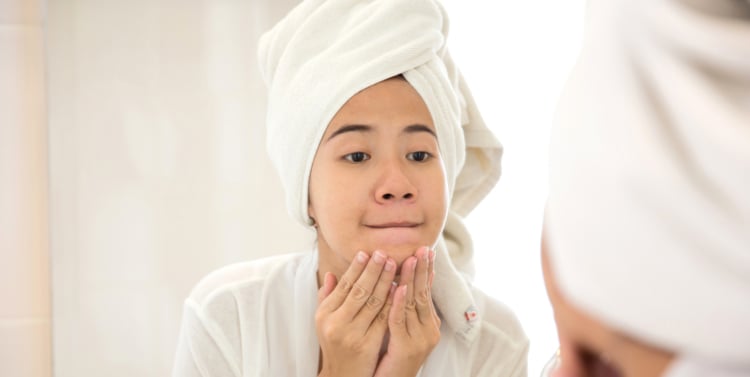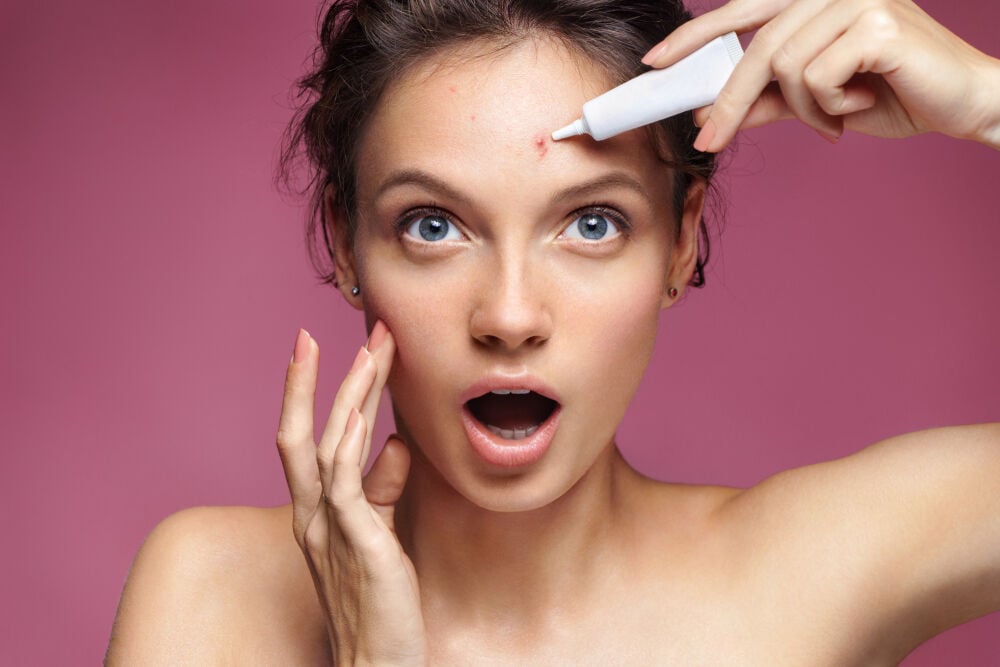Hormonal acne refers to breakouts that occur due to hormone fluctuations, particularly a rise in androgens such as testosterone. Although the acne that results from hormonal fluctuations in puberty is typically called hormonal acne, it may affect adults at any age. It’s particularly common during menstruation and menopause.
-
Tracking cycle
-
Getting pregnant
-
Pregnancy
-
Help Center
-
Flo for Partners
-
Anonymous Mode
-
Flo app reviews
-
Flo Premium New
-
Secret Chats New
-
Symptom Checker New
-
Your cycle
-
Health 360°
-
Getting pregnant
-
Pregnancy
-
Being a mom
-
LGBTQ+
-
Quizzes
-
Ovulation calculator
-
hCG calculator
-
Pregnancy test calculator
-
Menstrual cycle calculator
-
Period calculator
-
Implantation calculator
-
Pregnancy weeks to months calculator
-
Pregnancy due date calculator
-
IVF and FET due date calculator
-
Due date calculator by ultrasound
-
Medical Affairs
-
Science & Research
-
Pass It On Project New
-
Privacy Portal
-
Press Center
-
Flo Accuracy
-
Careers
-
Contact Us
Hormonal Acne: Causes, Types, and Treatments


Every piece of content at Flo Health adheres to the highest editorial standards for language, style, and medical accuracy. To learn what we do to deliver the best health and lifestyle insights to you, check out our content review principles.
What is hormonal acne?
Hormonal acne is due to hormonal fluctuations, especially an increased level of androgens such as testosterone. Although it often affects teenagers during puberty, hormonal acne may occur at any stage of an adult’s life. Furthermore, hormonal imbalances may lead to acne in adults who have underlying medical conditions.
Symptoms of hormonal acne
During puberty, hormonal acne often appears on the T-zone, which includes your nose, chin, and forehead. Hormonal acne in adults may start on the lower area of the face, which includes the jawline and lower cheeks.
Acne may appear as comedones, which are of two types — whiteheads and blackheads.
Blackheads (open comedones) open at the surface of the skin, and they appear black after sebum interacts with the air.
Whiteheads (closed comedones) are closed beneath the skin surface and appear white on top.
Touching or picking at comedones may rupture the follicle wall, but some ruptures also happen spontaneously. When this occurs, sebum and bacteria from the ruptured pore can spread to the surrounding area, leading to inflammation. Inflammatory acne starts as papules, which are commonly referred to as pimples.
Acne may also appear as:
- Papules: Small, raised, red bumps from inflammation or infection of the hair follicles
- Pustules: Small and red pus-filled pimples
- Nodules: Similar to papules but larger in diameter, this type is also dense and painful and lies deep in the skin
- Cysts: Large lumps under the skin that contain pus and may be painful and tender
Causes of hormonal acne
Conditions that affect hormone levels can trigger acne. Here are a few examples:
- Puberty
- Menstruation
- Menopause
- Polycystic ovary syndrome
- Increased levels of androgens
According to estimates, acne occurs in around 50 percent of the female population ages 20 to 20 and 25 percent ages 40 to 49.
A rise in testosterone levels may trigger the excessive secretion of sebum from glands in the skin. It may also change the activity of certain skin cells, leading to an infection of the hair follicles by bacteria known as Cutibacterium acnes. This can create hormonal acne.

Does progesterone cause acne?
Yes, fluctuation in the levels of sex hormones (including progesterone) during your menstrual cycle may also contribute to acne before your period.
Progesterone levels rise during the middle of the cycle. This may stimulate the sebaceous glands in the skin. However, the role of progesterone in sebum production is uncertain.
Increased progesterone may also raise your body temperature and worsen sweating, leading to clogged pores. This buildup of sebum beneath the skin’s surface — along with dirt, dead skin cells, and bacteria — results in breakouts of acne before and during your period.
Testosterone and acne: Are they connected?
Yes, testosterone and acne are connected. Hormonal acne usually occurs in response to a rise in certain hormones, especially testosterone. During puberty, the production of testosterone increases and can prompt hormonal acne in teenagers. Rising testosterone may stimulate more sebum production from glands in the skin. Then, excessive sebum combines with dirt and dead skin cells, clogging the skin pores. The infection of these clogged pores by acne-causing bacteria may lead to pimples. Your body’s immune system may react to the bacteria and its metabolites and produce inflammation, which looks like redness alongside acne lesions.
Acne in menopause
Acne during menopause can occur because of hormonal fluctuations. People who develop acne around menopause usually have normal androgen levels but reduced levels of estrogen. Due to this imbalance, sebum production increases, and acne may flare.
For some people, hormone replacement therapy (HRT) can actually trigger acne.
Severity of acne
Scientists have developed a few grading systems to assess the severity of acne. According to the Global Acne Grading System (GAGS), acne can be mild, moderate, severe, or very severe.
To assess your acne severity based on GAGS, you’ll first need to calculate the local acne score for each affected area on your body.
Local score = Location factor × Grade of the most severe lesion in the location
Location factor:
Nose = 1
Chin = 1
Forehead = 2
Right cheek = 2
Left cheek = 2
Chest and upper back = 3
Grade of the most severe lesion in that location:
Comedone = 1
Papule = 2
Pustule = 3
Nodule = 4
The global score is the sum of local scores. For example, if you have papules on both your cheeks and some comedones on the chin (but don't have more severe lesions), the global score is (2 × 2) + (2 × 2) + (1 × 1) = 9.
Acne severity according to GAGS:
Mild: 1–18
Moderate: 19–30
Severe: 31–38
Very severe: More than 39
Take a quiz
Find out what you can do with our Health Assistant

Hormonal acne treatments
Unless you have mild hormonal acne, over-the-counter treatments may not be successful. Your health care provider may recommend oral medicines, which can help balance your hormones and clear the skin. Common options include anti-androgen drugs and oral contraceptives.
Oral contraceptives
Combined oral contraceptives can normalize testosterone production, helping clear away acne. When acne is severe and other treatment methods are ineffective, your health care provider can prescribe combined oral contraceptives, after discussing the benefits and risks.
To choose the right contraceptive and dosage, your health care provider will look at your hormone blood test results, age, menstrual cycle regularity, medical history, and other factors. Self-medication using oral contraceptives can be dangerous.
Anti-androgen drugs
Other drugs work by reducing the androgen hormone. Most people have natural levels of androgen, but excessive androgen may cause acne by increasing the production of sebum.
Anti-androgen drugs keep the body from producing excessive androgen and stabilize the levels of this hormone.
They are not appropriate for everyone; be sure to discuss the risks and benefits with a health care provider.
Retinoids
Some people may need topical retinoids to treat mild hormonal acne. These derivatives of vitamin A are available as over-the-counter gels, lotions, and creams. A dermatologist can also suggest a prescription-strength product to keep your acne at bay.
While using topical retinoids, make sure to use sunscreen daily, as they increase your risk of getting a sunburn.
Natural remedies for hormonal acne
Certain plant-based strategies can treat mild hormonal acne. However, they may be not as effective as conventional methods, and research on the efficacy of these treatments is lacking. One of these natural treatments is tea tree oil. Although tea tree oil is generally safe, your health care provider can verify whether it will interact with any medications you’re taking.
Tips for people with acne
These self-care tips may help clear acne or keep it from getting worse:
- Wash your face gently, no more than twice a day, and after heavy sweating.
- Use mild cleansers or soaps and lukewarm (not hot) water.
- Avoid exfoliating products or harsh scrubs.
- Don’t rub, pick, or scrape your pimples since this can cause inflammation.
- If you wear makeup, look for non-comedogenic options when possible.
- Avoid humid environments, which lead to sweating.
Excessive washing and scrubbing can actually worsen acne, as it may remove too much oil from your skin and cause irritation. In response, your skin may secrete more oil, worsening the acne.
Key takeaways
Hormonal acne happens because of hormone fluctuations, especially testosterone. A rise in testosterone may stimulate the excessive sebum production from the sebaceous glands. When this sebum combines with dirt, bacteria, and dead skin cells, it results in clogged pores and acne.
Hormonal acne at puberty may occur on the T-zone — the nose, forehead, and chin. Acne may also occur during menopause due to fluctuating hormones. If you visit a dermatologist, they may categorize your hormonal acne as mild, moderate, severe, or very severe. Different kinds of treatment are available for hormonal acne, including topical products, oral contraceptives, or anti-androgen drugs.


Hey, I'm Anique
I started using Flo app to track my period and ovulation because we wanted to have a baby.


The Flo app helped me learn about my body and spot ovulation signs during our conception journey.


I vividly
remember the day
that we switched
Flo into
Pregnancy Mode — it was
such a special
moment.
Real stories, real results
Learn how the Flo app became an amazing cheerleader for us on our conception journey.




